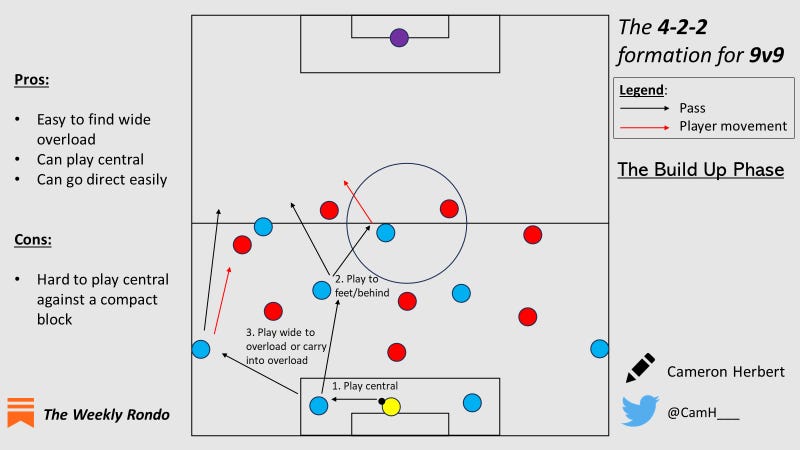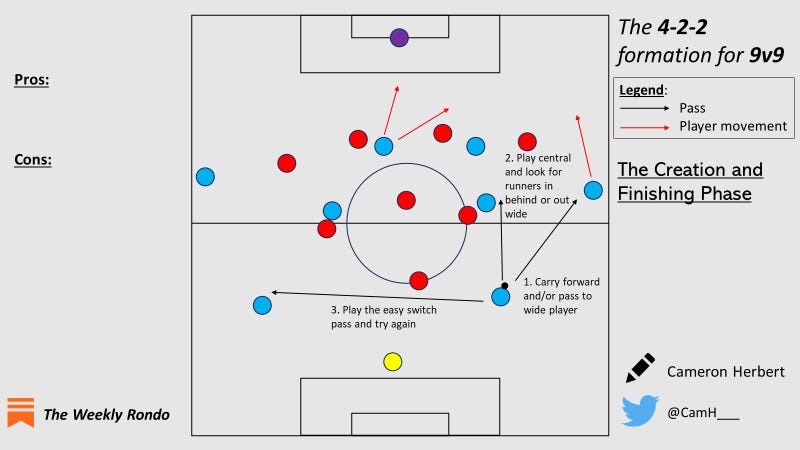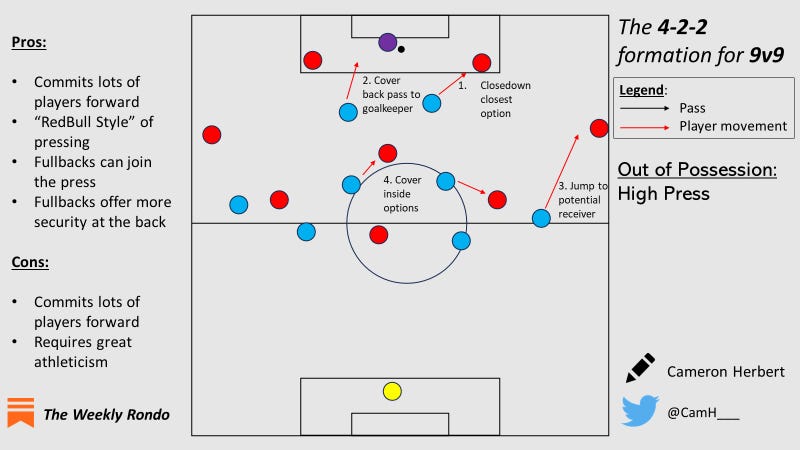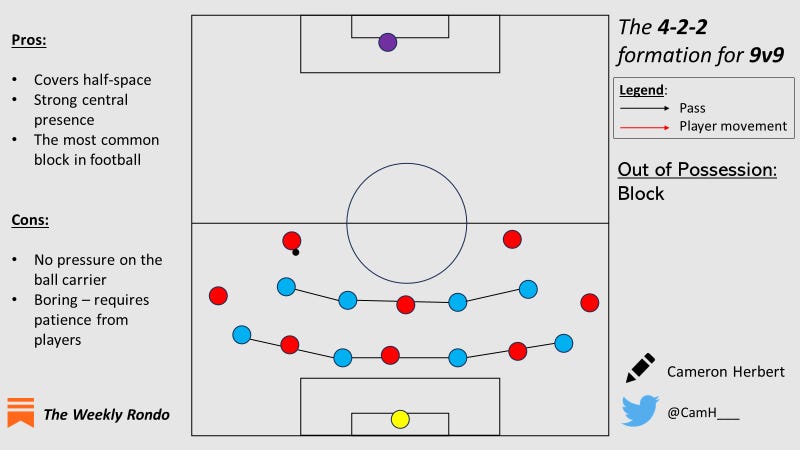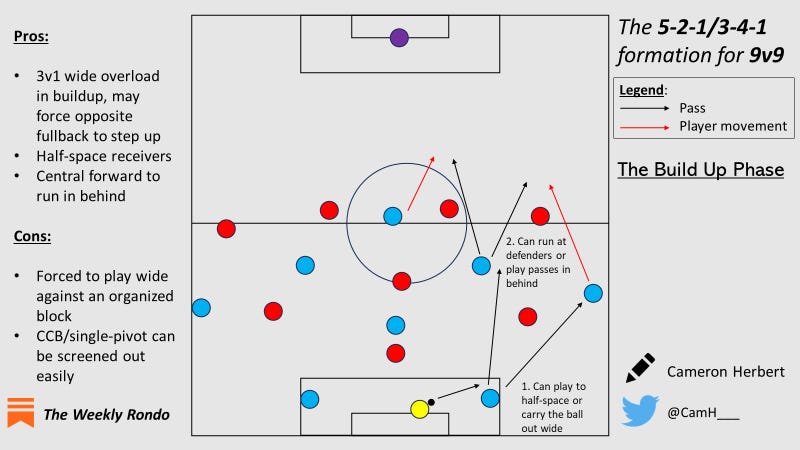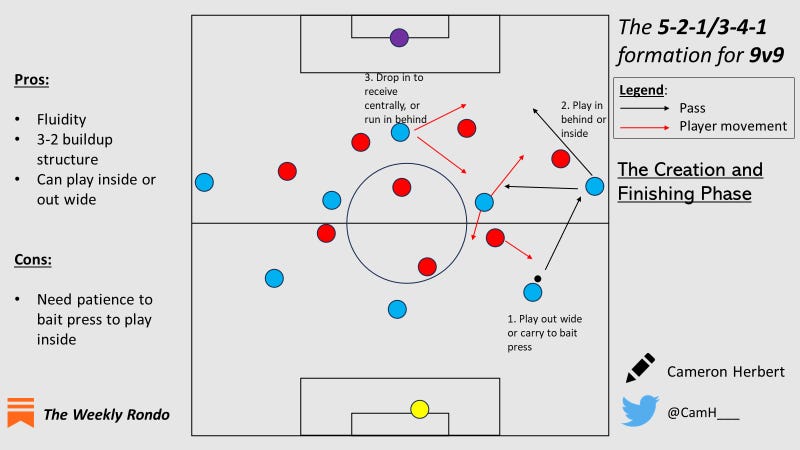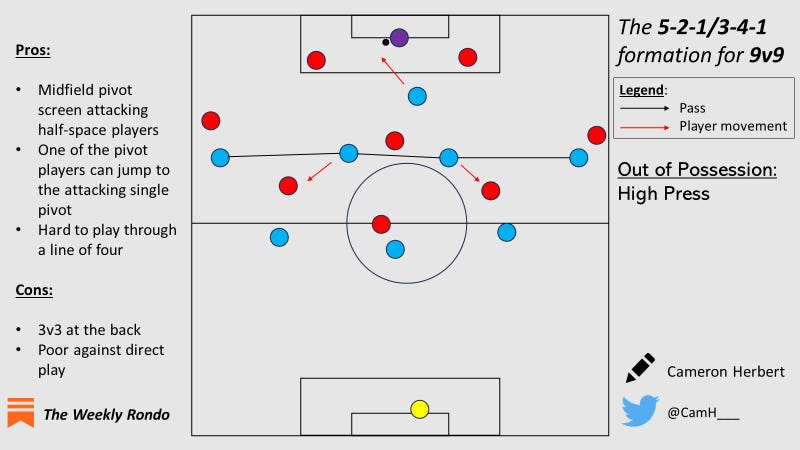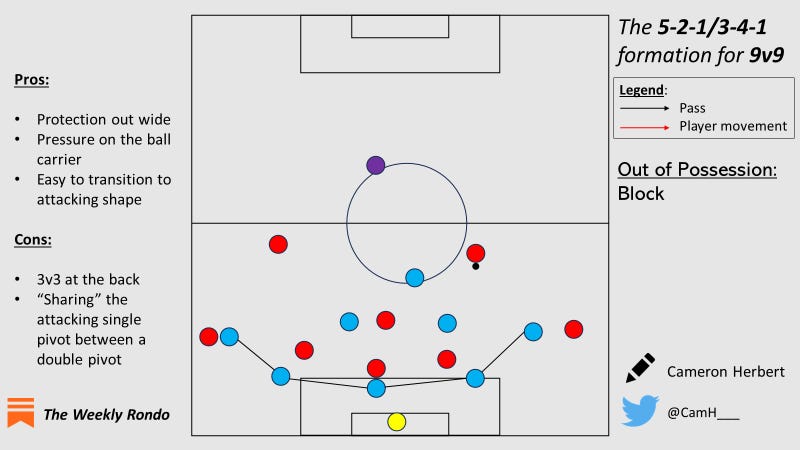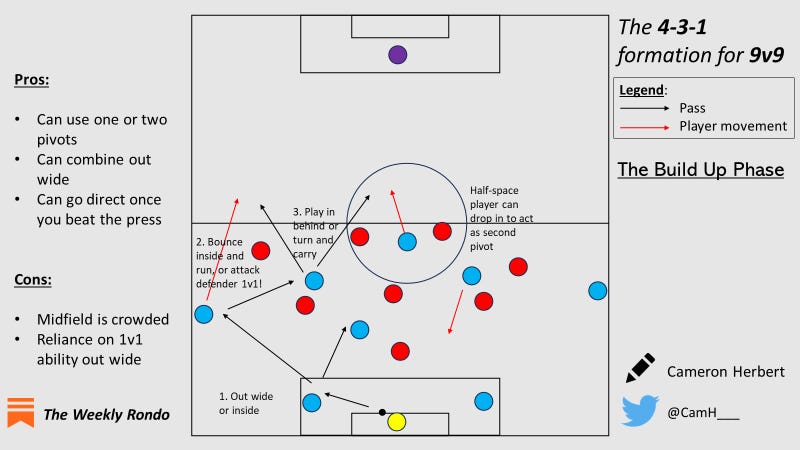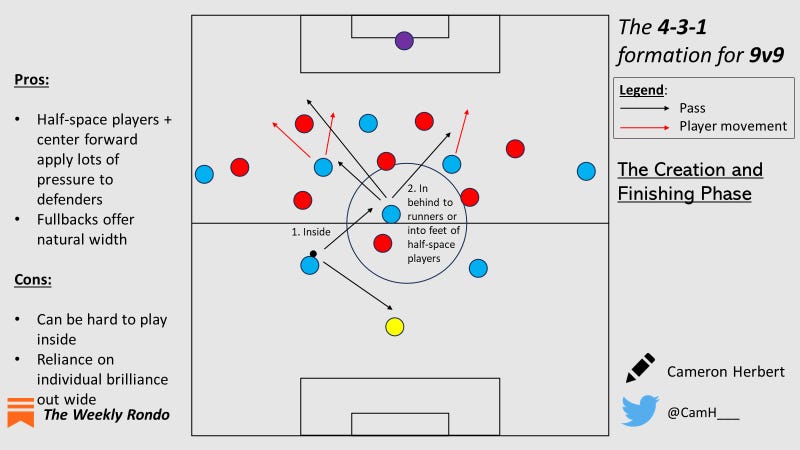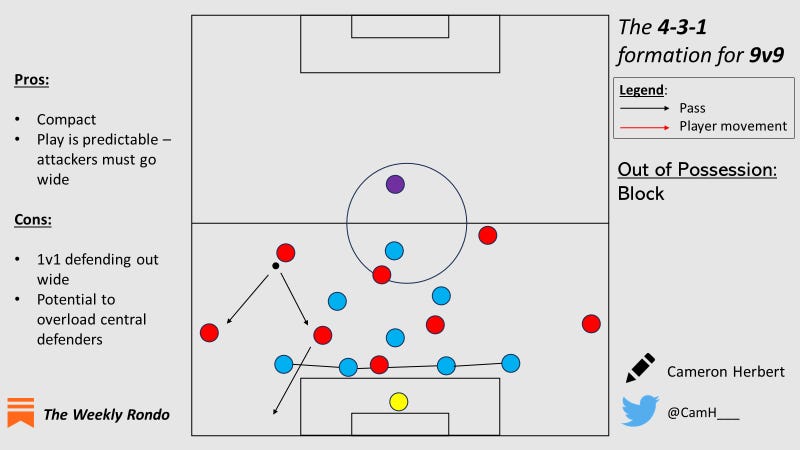I’m back! This is a continuation of our youth football formation series. Last month I wrote about 7v7, now I’m here to talk about 9v9!
We have three formations and tactical ideas that you can use depending on your game model and desired outcomes for your players.
4-2-2
3-4-1/5-2-1
5-3-1
Before we continue, hit the “heart” button so that more people see this newsletter. I don’t like asking for “likes” but it’s the best way to grow The Weekly Rondo. If you like this post Substack will share it!
What’s your favorite 9v9 formation?
4-2-2
This formation should be used if you plan on developing players in a system with two central forwards and two central pivot players. Ideally, this builds into a 4-4-2 or 4-2-2-2 system.
This builds nicely from the previous small sided games tactics piece I wrote, as all we’re doing is adding fullbacks! I strongly recommend adding fullbacks instead of wide midfielders/wingers because a 9v9 pitch is quite small compared to an 11v11 one, and having so little width during build up could lead to issues in youth football.
In possession:
Build Up:
Last month, the width was from the forwards and central defenders in the 7v7 variant. So, your players may take time to adjust to their new roles.
The midfielders will remain central similar to how they might in a traditional 4-4-2 and 4-2-2-2.
Width will be provided by one of the two central forwards. Their starting position may resemble wingers, but once the ball is moving they will be free to move appropriately in response to the defending team, ball, and their teammates.
We want to leave space for our newly introduced fullbacks to bomb forward and provide more natural width.
With fullback, we now have the luxury of being able to use them for bounce passes back inside so that our central defenders can play a central pass.
Creation and Finishing:
One of the central forwards can move centrally while the other remains on the same side as the ball so as to pin an opposing defender while also providing width, similar to 7v7.
However, with fullbacks, we can keep our two forwards central to pin the oppositions central defenders, and allow our fullbacks to come forward and force a decision from the defenders.
The pivot players react similarly to the central forwards with the key difference being that one of them remains wider than the central defender furthest from the ball so that your team can switch play if needed.
Out of Possession:
This style of play resembles the famous “Red Bull” brand of football and therefore requires athletic players, or players who are able to understand how pressing works.
High Press:
This system still uses a man oriented defending system when defending high up the pitch.
One central forward presses the ball carrier while the other marks the nearest passing option. There is virtually no difference to the 7v7 formation, except that the central pivot players have more freedom to jump because of their fullbacks being able to help defend.
Mid/Low Block:
During periods of settled possession, the 4-2-2 can turn into a 4-4! The wide forwards can drop beside the pivot players while our fullbacks are and central defenders are able to retain their natural positions on the pitch.
Two lines of four are very difficult to break down - most professional teams defend with two banks of four for a reason! So, during long periods without the ball you can breathe easy knowing that you’re using one of the most successful formations for defending.
The downside here is that without any forwards, there’s very little or no pressure on the attackers, so you may be without the ball for a while.
Pros:
Two forwards
Direct
Favors athleticism
Exciting high press
Cons:
Favors athleticism
Direct
Little pressure when defending in block
5-2-1/3-4-1
This is the formation that most naturally leads into a wingback/three central defender system. Compared to our 7v7 tactics piece, we are just adding wingbacks or wide midfielders.
In Possession
Build Up:
Similar to the 7v7 set up, we still have a team that can use their center central defender as a single pivot in midfield. The nuance here is that by adding two players out wide, our two inside players become our half-space players.
In build up we have an excellent 3v1 overload with our right central defender, right wingback and right sided half-space player. This forces the defender in the oppositions back line to make a decision: jump forward or stay in line.
Creation and Finishing:
Here we can see potential for typical rotations in a 3-2 build up system.
There's options to go direct or rely on individual brilliance. Players are much smarter than we give them credit for. This is more than doable with most players 10 and older.
The downside is needing to wait for the right moment to play those killer inside passes. Those come when players wait for the right moment to play a wide pass that goes back inside to punish the pressing player.
Out of Possession
High Press:
A line of four is very difficult to break down at any level. With both central players screening the attacking half-space players, the attackers will now need to wait for their teammates to open up and create space.
In this type of press we want to use our center forward to cut off back passes to the goalkeeper or to the opposite central defender.
Something to be weary of is that the attackers may choose the direct option, in which case you will be defending a 3v3 in what is essentially an artificial transition.
Mid/Low Block:
This is probably one of the best formations for transitioning into your in possession/attacking shape. The players move into their positions naturally because there’s so few shared roles.
For example, in a 4-2-2, the forwards may need to act as wide players and central players, so transitioning to defense or attack can cause a second or two of confusion before your players make a decision.
Opponents will have a very hard time scoring and will likely be reduced to moments of individual brilliance or long shot/low probability methods of chance creation.
This is easily becoming one of my favorite formations in youth football. It allows you to keep most possession and pressing based principles, while also afforidng you the luxury of being able to transfer players to similiar systems in the future.
Pros:
Flexible for different game models
Great defense
Easy combinations
Cons:
Zonal defending understanding needed
“Park the bus” situation when first line of press is beaten
4-3-1
The positions and responsibilities are quite clear in this shape as it most naturally builds into the 4-3-3 formation that so many coaches and academies are playing these days.
This is the progression from the 2-3-1. All we’ve added is fullbacks! However, they may take up the roles of wingers, depending on the players you have.
In Possession
Build Up:
This is similar to our previous formation, the 3-4-1, however I would suggest using this if your wide players look like they may develop into wingers rather than fullbacks!
The ideas and principles are generally the same, the caveat being that you may not have great wide players or central players, so your chance creation may be to go direct.
That said, the build up is relatively fluid! We have the luxury of allowing one of our half-space players drop into the buildup should our team struggle to beat the press.
Creation and Finishing:
I place a large importance on playing centrally here so that we can “explode” out wide to take advantage of those wide players, or go in behind.
With our central forward and two half-space players, our single pivot has options to go carry the ball and attack the defenders, play a ball in behind, or at worst play a wide pass to the bombing fullbacks.
Out of Possession
High Press and Block:
I’ve decided to include these together as one because the half-space players have the same responsibilities no matter if they’re pressing high or sitting in a block.
The central forward will guide the press while the half-space players will screen the attacking half-space players, all while keeping an eye on their single pivot player. These two half-space players have a massive responsibility and must be willing and able to communicate.
Things like “mine” or “yours” or “cover” are simple words we can use when managing a shared responsibility in defending.
There may be some issues with defending the wide areas. The defending fullback may be stretched out of position. It’s up to you to decide which player shuffles over to cover the out of position fullback.
What is critical is deciding how much pressure you want your ball sided half-space player to put on the side of the attack when defending. Depending on how athletic or unathletic they are, they may leave the central area vacant for attackers to receive in.
Pros:
Great for wingers and fullbacks
Exciting high press
Cons:
Space behind widest players
Conclusion
The value we can get from formations at youth level comes from how well the players are prepared for the older age groups.
If your game model favors a certain type of player over another, your formation and coaching points need to reflect that in order to best prepare your players.
When it comes to choosing which formation to use, look at what your academy or club is playing at its oldest age group and work from that.
If you enjoyed this, consider referring a friend to earn a free month to your paid subscription!





